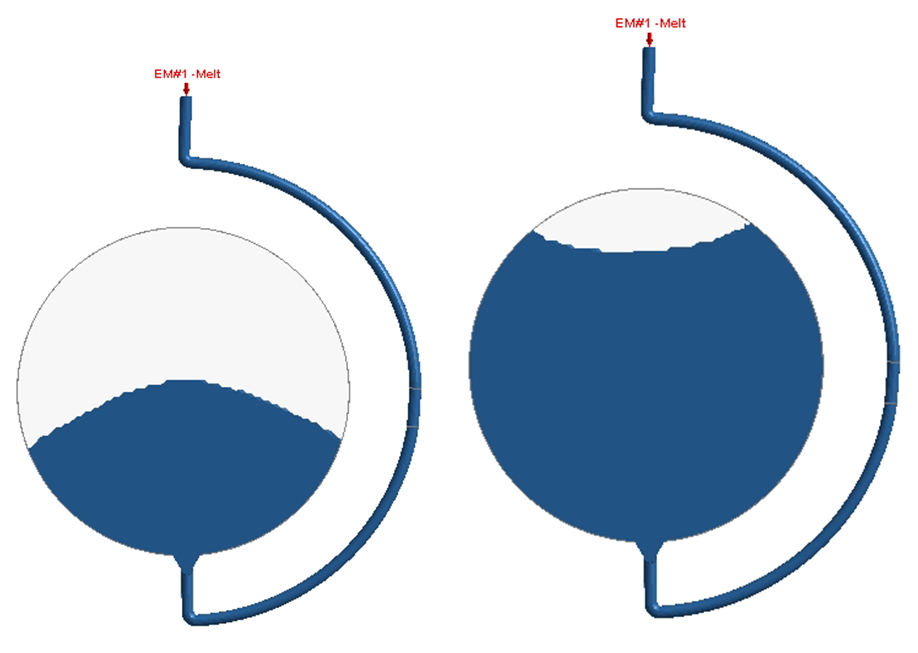Injection molding is the most common manufacturing process for producing plastic parts. Though the molding technology is well-developed, there is a long-running problem requiring an urgent solution for the industry: to date, prior state-of-the-art predictive engineering tools have always provided unsatisfactory results regarding “so-called ear-flowâ€, in which the advance of the flow front in the center of the cavity is obviously slower than at the edges, as shown in Fig. 1. Not all polymers have consistently yielded the ear-flow. The effect of part thickness on the flow is clearly seen for certain polymers. The ear-flow is observed notably in thin parts but has not been seen in thicker parts. A faster injection rate easily results in ear-flow in contrast to a slower injection rate. These phenomena are urgently needed to be clarified by CAE technology for the industry. The past flow simulation only considers the sheer effects. However, the real flow behavior is the comprehensive effects of sheer and extension effects. Thus, the Moldex3D R&D team has been committed to developing a new viscosity model, called the eXtended GNF (GNF-X) model, through which the weighted viscosity with the coexistence of shear and extensional flow can be derived. Thus, the primary objective of this work is to simulate a reliable Ear-flow for neat polycarbonate (PC) material in an injection molded disk via a new Moldex3D Flow solver coupled with the GNF-X equation [U. S. Patent Pending in USPTO with Application No. 62/886,539 (2019)]. In this work, the primary objective is to simulate the ear-flow in injection molding via a new viscoelastic model, as compared with the GNF viscosity model. Referring to the work of Beaumon [14], a practical injection mold filling simulation of the polycarbonate (PC) fluid for the disk cavity was performed by the commercial injection molding simulation software, Moldex3D. The melt temperature and mold temperature are 293.3 oC and 82.2 oC, respectively. The injection time is 1.0 seconds. Using the cross model of the GNF shear viscosity, Fig. 2 shows the concave front at 50%-filled cavity and the flat front at 90%-filled cavity. This is not consistent with the real-world status. Next, the new GNF-X model with the extension viscosity is used in the Moldex3D flow computation. Significantly, Fig. 3 exhibits the advancement of the flow front in the centre of the cavity is significantly slower than at the edges, namely, so-called “ear-flowâ€. Such a prediction is satisfactory and validates that Moldex3D’s new extension viscosity function can successfully resolve a long-running problem of ear-flow simulation. Two-Component Epoxy Resin Adhesive two part epoxy, epoxy adhesive,epoxy glue for metal,metal adhesive,strongest glue,epoxy structural adhesive Dongguan Shuangzhan Industrial Co.,Ltd , https://www.lingwogroup.com

Ivor Tseng, Scientist at R&D Division, Moldex3D

Fig. 1 Schematic of ear-flow

Fig. 2 Injection molded disk simulation using the GNF shear viscosity model for PC

Fig. 3 Injection molded disk simulation using the new GNF-X viscoelastic model for PC
Long-running Problem of Ear-flow Simulation Solved by Groundbreaking Viscosity Model
Characteristics of two-component epoxy resin adhesive
1.Strong bonding force: It has excellent bonding performance to various materials and can form a firm and lasting bond.
2.Adjustability: The curing time and performance can be controlled by adjusting the ratio of the two components.
3.Chemical resistance: It can resist the erosion of various chemical substances such as acids, alkalis, and salts.
4.High mechanical strength: After curing, it has high hardness and strength and can withstand large stresses.
5.Good electrical insulation: It is suitable for insulation and encapsulation in the field of electronics and electrical appliances.
6.Good heat resistance: It can maintain stable performance within a certain temperature range.
Uses of two-component epoxy resin adhesive:
In the industrial field of two-component epoxy resin adhesive:
Used for bonding and repairing parts in mechanical manufacturing, such as the connection of metal structures.
Used for bonding and structural reinforcement of composite materials in the aerospace field.
Used for encapsulation and fixation of components on circuit boards in the electronics and electrical appliance industry.
In the construction field:
Used for repairing and strengthening concrete structures to improve the strength and durability of the structure.
Used for pasting tiles, stones, etc. to provide a firm bonding effect.
In the handicraft production of two-component epoxy resin adhesive:
Can be used to make exquisite resin handicrafts such as sculptures and accessories.
In other fields:
Used for bonding and sealing body parts in automobile manufacturing.
Used for repairing and anti-corrosion of ship hulls in shipbuilding.
